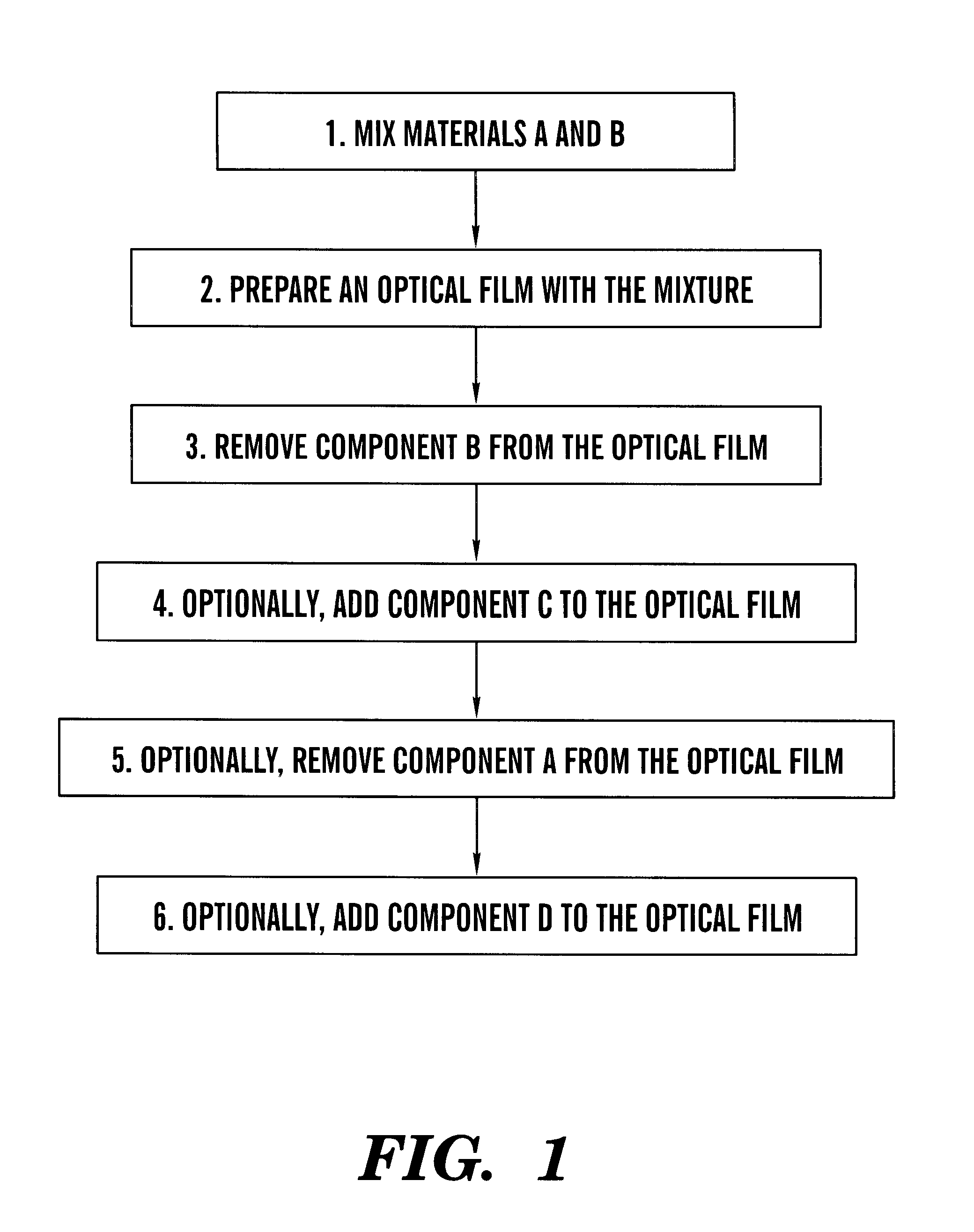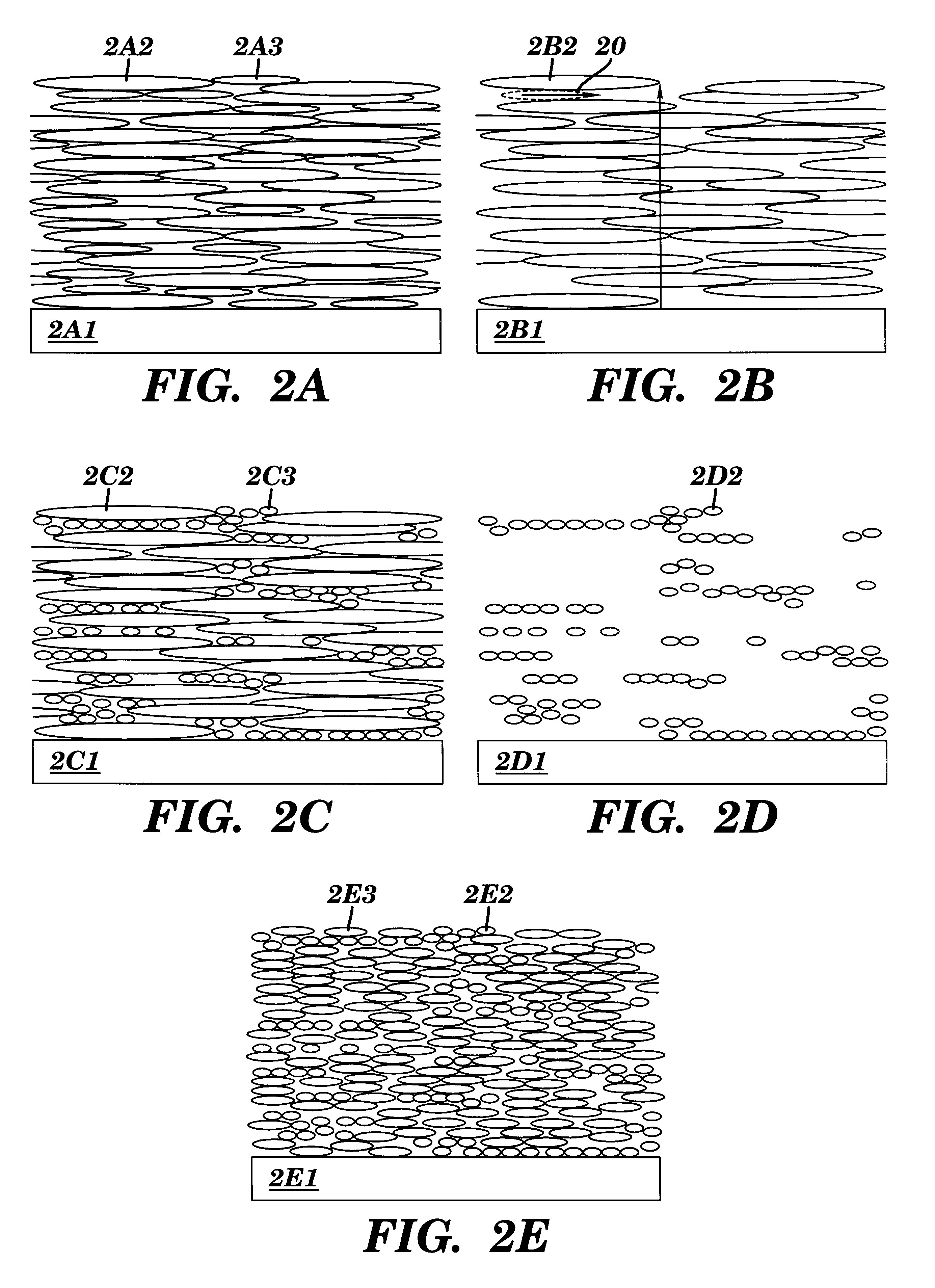Composite nonlinear optical film, method of producing the same and applications of the same
a nonlinear optical film, composite technology, applied in the field of composite films, can solve the problems of affecting the performance of affecting the performance of the component, and affecting the quality of the liquid crystal material,
- Summary
- Abstract
- Description
- Claims
- Application Information
AI Technical Summary
Problems solved by technology
Method used
Image
Examples
example i
FIG. 4A shows experimental reflectance spectra of film samples that were prepared in accordance of the invented process. Curve 4A1 is the reflectance spectrum of a planar CLC film of a blend consisting of a BASF acrylate CLC polymer #181 (45% by weight), a chiral nematic (53% by weight) and a small amount of Ciba-Geigy photo-initiator Irgacure 184 (2% by weight). The chiral nematic itself consisted of Merck low-molecular-weight nematic liquid crystal E44 and chiral dopant R1011 (0.7% by weight with respect to the chiral nematic). The film was 20 .quadrature.m thick and was prepared in a conventional manner, i.e., two glass substrates were first spin-coated with a thin polyimide alignment layer which are mechanically rubbed. Glass beads of 20 .quadrature.m in diameter were then dispersed between the two glass substrates, with the coated sides facing each other. The CLC blend was then introduced between the substrates by capillary action. After mechanically shearing (relatively small ...
example ii
FIG. 4B shows experimental reflectance spectra of film samples that were prepared in accordance with the invented process. Curve 4B1 was the spectrum of a planar CLC film of the blend consisting of a BASF acrylate CLC polymer #181 (26% by weight), a chiral nematic (69% by weight) and a small amount of Ciba-Geigy photo-initiator Irgacure 184 (5% by weight). The chiral nematic itself consisted of Merck low-molecular-weight nematic liquid crystal E44 and chiral dopant CB15 (24.4% by weight with respect to the chiral nematic). The film was 20 .quadrature.m thick and was prepared in a similar manner described above with respect to Example I. After the film sample was photo-polymerized with a UV lamp and one of the substrates was removed, the reflectance 4A1 was taken from the `naked` film side. In the context of foregoing discussion, A was the BASF 181 polymer, B was the low-molecular chiral nematic. A film with the blend (A+B) was prepared. The B-component (the low-molecular-weight chir...
example iii
FIG. 4C shows experimental reflectance spectra of film samples prepared in accordance with the invented process. Curve 4C1 is the reflectance spectrum of a planar CLC film of the blend consisting of a BASF acrylate CLC polymer #181 (45% by weight), a chiral nematic (53% by weight) and a small amount of Ciba-Geigy photo-initiator Irgacure 184 (2% by weight). The chiral nematic itself consisted of Merck low-molecular-weight nematic liquid crystal E44 and chiral dopant R1011 (0.7% by weight). The film was 20 .mu.m thick and was prepared in a similar manner described above. After the film sample was photo-polymerized with an UV lamp and one of the substrates was removed, the reflectance 4A1 was taken from the `naked` film side. In the context of foregoing discussion, A was the BASF 181 polymer, B was the low-molecular chiral nematic. A film with the blend (A+B) was prepared. The B-component (the low-molecular-weight chiral nematic) was subsequently removed by dissolving with acetone, re...
PUM
| Property | Measurement | Unit |
|---|---|---|
| thick | aaaaa | aaaaa |
| center wavelength | aaaaa | aaaaa |
| refractive index | aaaaa | aaaaa |
Abstract
Description
Claims
Application Information
 Login to View More
Login to View More - R&D
- Intellectual Property
- Life Sciences
- Materials
- Tech Scout
- Unparalleled Data Quality
- Higher Quality Content
- 60% Fewer Hallucinations
Browse by: Latest US Patents, China's latest patents, Technical Efficacy Thesaurus, Application Domain, Technology Topic, Popular Technical Reports.
© 2025 PatSnap. All rights reserved.Legal|Privacy policy|Modern Slavery Act Transparency Statement|Sitemap|About US| Contact US: help@patsnap.com



